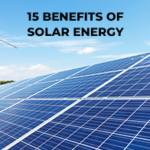Which Among The Energy Sources Is Cheaper, Solar Or Wind?
Renewable energy sources like solar and wind are becoming increasingly popular as we move towards a more sustainable future. But one question often arises: which of these energy sources is cheaper?
The answer to this question is complex, as the cost of solar and wind energy depends on various factors. This article will explore solar and wind power costs and determine which is cheaper.
What Is Wind Energy?
The term “wind” is a technical description of natural energy. When sunlight’s radiation heats, the uneven surface of Earth’s hot air rises while cool air can settle. Variations in atmospheric pressure result in the breeze, a dynamic (motion-based) power source.
Wind turbines can capture this vibrant power. When the breeze blows across the turbine’s blades, the generator turns the power from the blade’s motion into mechanical energy that can later be transformed into energy that can be used for pumping water or providing power to homeowners’ businesses, homes, and even schools.
What Is Solar Energy?
Solar energy is sunlight’s radiation that reaches Earth. PV (photovoltaic) cells inside the panels use sunlight to generate electricity when it hits the cells.
Advantages
Solar Energy Has Advantages Over Wind Power:
- Energy from sun is the most reliable power output as compared to the other sources. Electricity production can be accomplished on a large scale using solar farms.
- In contrast to wind turbines, solar panels don’t require any specific area for installation, as they can be put on the rooftops of homes or offices.
- These panels barely make sound, while air turbines can be loud.
Benefits Of Wind Power Over Solar Power:
- Energy from the sun cannot be harnessed in the evening or in cloudy weather, whereas the other can be harnessed during the night.
- The wind is a more efficient source of power than the other. Less CO2 is released into the atmosphere using air turbines. These turbines produce 4.64 grams of CO2 per kWh, while solar panels release 70 grams of CO2/kWh.
- Wind power is less energy-intensive and generates more power than those panels.
Factors to Consider
Location:
Wind turbines are ideal choices for populous places. The air in suburban and urban regions is heavily affected by trees, buildings, and other obstructions. This can result in lower electricity production. Additionally, the tiniest residential air turbines measure 10 meters high.
These elements make air turbines the perfect choice for homeowners with large plots of land in rural areas with windy and chilly regions. Solar power is more minor and can be placed on the rooftops of buildings, houses, and other buildings, as well as on the roofs of companies and buildings. It is generally the best option for urban and suburban areas.
Noise:
Air turbines can be extremely noisy. It is impossible to hear any sound from the solar panel.
Consistency:
The sun’s rays are not necessary for an air-powered system to produce energy. It produces electricity around all hours of the day. However, the weather remains an issue for both systems.
Solar panels can generate electricity even when there are clouds, unlike air turbines, which will not create any electricity if the breeze is weak or ineffective.
Efficiency
Air turbines typically capture 60 percent of the energy that flows through them, in contrast to solar panels’ 18% to 22 percent performance. It is, therefore, evident that a wind turbine in your home will produce more efficient results than several panels.
If you’re in a protected sun-drenched area, these panels can produce more electricity than air turbines since, in urban areas; it’s much more difficult to generate electricity because of the absence of wind on most days.
Reliability
Of the two, the solar panels require more maintenance. There aren’t any moving parts, and, in addition, the solar system is less vulnerable to high winds and lightning destruction.
Solar Or Wind Power?
Wind power is currently higher than solar when it comes to the overall percentage of electricity produced.
Intelligence is the species’ capacity to coexist harmoniously with its environment by using the best electricity sources for the area. We wouldn’t expect power from sun to be able to beat the electricity source like hydropower in those of the Pacific Northwest. Similar to how we wouldn’t anticipate air power to rise in urban areas with dense populations, such as New York City.
The energy future is a decentralized electricity system, meaning that the energy source is sourced and consumed locally. For those who want to make a significant change in their lives, to move towards a more sustainable and environmentally sustainable lifestyle, renewable energy provides the perfect opportunity to contribute to the change. Wind Turbines may offer different benefits to homeowners; however, it will surely be a significant part of the partnership in using alternative power as we work towards a zero-carbon net.
Last Thoughts
In conclusion, both solar and breeze energy are renewable, clean, and low-cost sources of electricity that have the potential to power our world sustainably. Although each source has benefits and drawbacks, the choice ultimately comes down to the user’s particular requirements and available resources. However, as the cost of solar electricity continues to decrease, it is becoming an increasingly more cost-effective option in many parts of the world. In the end, deciding between the two sources is a matter of personal preference and is influenced by a number of criteria, such as location, the amount of electricity needed, and affordability. If you want any of these services than kindly contact “US Energy Discounts“.





